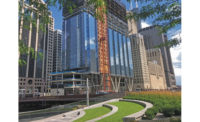The $231-million, 10-gate expansion of Concourse A at Charlotte-Douglas International Airport (CLT) was nearing the end of its design phase in early 2020 when the coronavirus pandemic upended the passenger aviation industry.
Rather than proceed with bond sales to get the construction manager at-risk project underway that summer as scheduled, Jack Christine, CLT’s chief infrastructure and development officer, says the airport elected to “slow-roll” the 191,848-sq-ft expansion for a year.
“We wanted to get a little deeper into what we were going to face with financial implications before we finished the drawings and got started on construction,” Christie explains.

To meet completion targets, teams have worked day and night to make the most of dry weather during an unusually wet winter.
Photo courtesy JE Dunn
As it turned out, the pandemic passenger slump at CLT was relatively short-lived. After dropping to about 50% of the previous year’s volume in early summer 2020, traveler counts regained sufficient momentum to allow the joint venture of JE Dunn and McFarland Construction to resume Concourse A’s preconstruction work in spring 2021. The project broke ground a year later.
Christine doesn’t second-guess the decision to delay, given the uncertainties of the time. But with CLT’s passenger volume now nearly back to pre-pandemic levels, he adds, “I wish we’d gone ahead, because we could use those gates today.”
Those trends are the driver behind Destination CLT, a $3.1-billion capital program of capacity enhancement projects begun in 2016, and funded via a variety of airport revenue streams, state grants and other sources.
In addition to supporting CLT’s role as American Airlines’ second-largest hub, the projects aim to accommodate a nearly two-decade-long uptick in the number of people boarding airlines at the airport, with total passenger volume topping 50 million in 2019.
In addition to the Concourse A expansion, the airport is also building a $608-million expansion of its existing 40-year-old main terminal lobby, providing much-need space for reconfigured security lanes, ticketing, baggage claim and circulation, as well as a new central energy plant and improved access to an adjacent hourly-rate parking structure.
Destination CLT has already delivered Concourse A’s $200-million first phase as well as renovations to Concourse B and a multiphase expansion of Concourse E, which wraps up this summer with a $50-million, 34,000-sq-ft addition. Grading for a new 10,000-ft parallel runway, the airport’s longest, will begin this spring, with other airfield and concourse renovations scheduled to begin work in the next few years.
“We have a lot going on,” Christine says, in what is perhaps a bit of an understatement.

Airport leaders say they haven’t been delayed by supply chain issues.
Photo courtesy JE Dunn
Expanded Horizons
The JE Dunn/McFarland team encountered a capacity crunch of its own as it re-engaged the construction market to get the Concourse A expansion back on track in 2021.
“With a big job like this, finding the right trade partners and getting interest from those that are already really busy has been a lot of work,” explains JE Dunn senior project manager Nick Christoffersen.
A factor in the project team’s favor is that most of the work is located outside the airport’s secured area—a benefit for logistics coupled with continuing awareness to prevent dust and debris from blowing across the busy airfield.
“It’s a monumental task to do that while working in and around a facility that’s already at double its original capacity.”
—Ben Goebel, Charlotte Office Leader, Gresham Smith
As of mid-February 2023, JE Dunn/McFarland had installed nearly 350 auger cast piles and more than 10,000 cu yd of concrete foundations for the two-story, 105-ft-wide barrel-roofed concourse and its 800-ft-long connector to the existing Concourse A, all of which were designed by C Design and Perkins+Will. The team was also one-third of the way into erecting 1,385 tons of structural steel framing.
Once the expansion tops out this summer, work will focus on installation of approximately 20,000 sq ft of dynamic auto-tinting glazing to help control interior temperature and sunlight as well as 35,000 sq ft of curtain wall, followed by dry-in and finishes.
At the same time, JE/Dunn/McFarland will be working to tie in a baggage system extension, “a task that will require a lot of phasing to be sure there are no disruptions,” Christoffersen says.
To meet the expansion’s planned substantial completion target of fall 2024, Christoffersen says the construction team has been working both day and night shifts, often overlapping each other. Weather has been less cooperative, however, with Charlotte experiencing an unusually wet winter.
“We’re ‘landlocked’ between existing apron paving around the site, so there’s nowhere for the water to go,” Christoffersen says. “We’ve been running a lot of hours to squeeze in as much work as we could between rain events.”

The terminal lobby expansion will increase throughput by consolidating five security checkpoints into three larger checkpoints.
Rendering courtesy Charlotte Douglas International Airport
Positive impressions
Nearby at CLT’s Terminal Lobby Expansion (TLE) project, the major constraint has been implementing a multifaceted expansion and renovation project without affecting airport operations or compromising passenger convenience.
“The airport made it clear early on that [this] is an airport first and a construction site second,’” says Ben Goebel, Charlotte office leader for lead designer Gresham Smith. “It’s a monumental task to do that while working in and around a facility that’s already at double its original capacity.”
“So far, we’ve not had to take any type of delay due to supply chain.”
—Jack Christine, Chief Infrastructure and Development Officer, CLT
Begun in late 2019 by the joint venture of Holder Construction, Edison Foard and R.J. Leeper, construction of the TLE continued largely unaffected through the pandemic, with the dip in passenger traffic too brief to make significant changes to the project’s six-phase, 60-month schedule, which is set for completion in fall 2025. Combining 175,000 sq ft of new facilities with 191,000 sq ft of renovations, the expansion will consolidate CLT’s five existing security checkpoints into three larger, more efficient stations, increasing throughput and streamlining Transportation Security Administration staffing. The project also includes new overhead and underground pedestrian walkways connecting the terminal with the parking garage and a new central energy plant housing the facility’s mechanical systems.
The signature feature of the TLE—and, perhaps, Destination CLT itself—is a 146,000-sq-ft steel truss and glass canopy stretching 155 ft across an elevated access road and terminal curb front.
Supported by sixteen 65-ft-tall columns adjacent to the garage and the TLE building envelope, the approximately 12-ft-tall trusses weigh approximately 45 kips each, Goebel says.
“Due to the weight and the complexity of the trusses, the erector elected to lift the trusses in two separate sections simultaneously and then secure them together in the air prior to unhooking from the crane,” Goebel says, adding that the steel truss erection is approximately half complete, with the entire canopy including glass and finishes slated to be complete mid-2024. “We performed extensive wind load analysis on the canopy design to ensure it could withstand gusts that might come through the expanded terminal and the garage.”
The first half of the TLE’s expansion phase opened in July 2021, with the second half set to be completed this coming November.
“We’re transitioning from working in the airport’s ‘front yard’ to its ‘living room,’—building new ticketing counters while existing ones remain in operation,” Goebel says. “Once those are complete, we’ll demolish the existing counters and begin work on one of the new security checkpoints.”
Goebel notes that the renovation also seeks to create more of a sense of place by incorporating elements that distinguish Charlotte as city, region and airport. For example, a 3,000-lb 15-ft bronze statue of city namesake Queen Charlotte is being rescued from near obscurity and relocated to a prominent “Queen’s Court” in the arrivals/departures area.
“We’re also incorporating wayfinding elements that reflect tie-ins to the area’s textile industry, topography and colors of the state’s well-known universities,” Goebel adds.

The airport’s Terminal Lobby Expansion includes 175,000 sq ft in new facilities and 191,000 sq ft of renovations, set for completion in 2025.
Rendering courtesy Charlotte Douglas International Airport
Supply Chain Survival
While the two Destination CLT projects haven’t been immune from cost escalation and supply chain issues, they largely have been free of the disruptive effects that have played havoc with construction schedules and budgets nationwide.
Christine says that’s a credit to both design/construction teams’ proactive management skills.
“So far, we’ve not had to take any type of delay due to supply chain,” he adds. “That is definitely something to be proud of. Teams are doing a pretty good job of that.”
The key, says Christoffersen, has been keeping a close watch on trends from the outset.
“When we were pricing this job out, it was the worst material escalation period we’d seen,” he says. “We worked with our trade partners during the bid time to have some room in their numbers to carry the standard escalation that we’d seen. Because of that, we really haven’t seen much escalation from our end.”
Goebel says a similar approach by the Holder-Edison Foard-Leeper joint venture has also proved beneficial. “We had our long-lead items on order early, which put us at the front of the line in terms of the supply chain,” he says.
Christine says that the airport’s “over-communication philosophy” has also helped keep surprises to a minimum.
“With a program as complex as this one, you’re not going to catch everything,” he says, “but you want to be sure you’ve caught just about everything you can so it’s not really a surprise; it’s just the way it is.”
It’s an approach to design and construction that Goebel heartily endorses.
“Maybe ‘over-communication’ should be the baseline,” he says, “rather than the extreme.”





Post a comment to this article
Report Abusive Comment